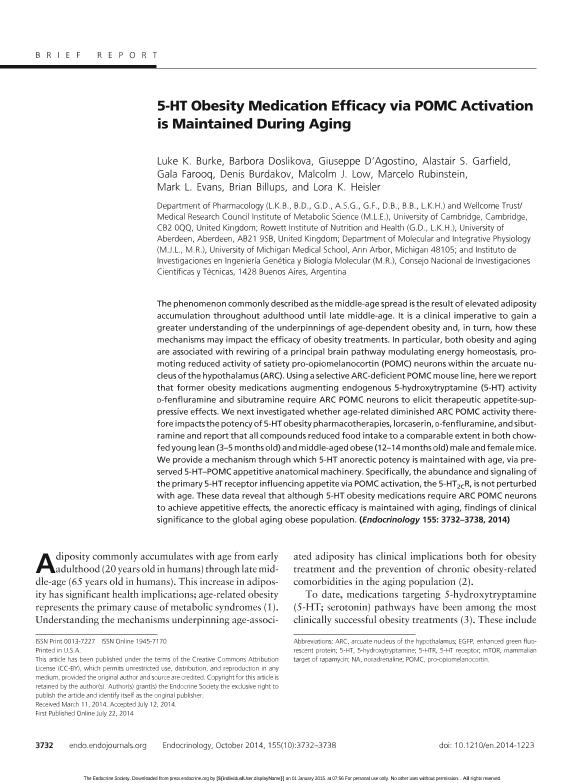Mostrar el registro sencillo del ítem
dc.contributor.author
Burke, Luke K.
dc.contributor.author
Doslikova, Barbora
dc.contributor.author
D'agostino, Giuseppe
dc.contributor.author
Garfield, Alastair S.
dc.contributor.author
Farooq, Gala
dc.contributor.author
Burdakov, Denis
dc.contributor.author
Low, Malcolm J.
dc.contributor.author
Rubinstein, Marcelo

dc.contributor.author
Evans, Mark L.
dc.contributor.author
Billups, Brian
dc.contributor.author
Heisler, Lora K.
dc.date.available
2016-02-03T20:21:34Z
dc.date.issued
2014-07-22
dc.identifier.citation
Burke, Luke K.; Doslikova, Barbora; D'agostino, Giuseppe; Garfield, Alastair S.; Farooq, Gala; et al.; 5-HT obesity medication efficacy via POMC activation is maintained during aging; Endocrine Society; Endocrinology; 155; 10; 22-7-2014; 3732-3738
dc.identifier.issn
0013-7227
dc.identifier.uri
http://hdl.handle.net/11336/4006
dc.description.abstract
The phenomenon commonly described as the middle-age spread is the result of elevated adiposity accumulation throughout adulthood until late middle-age. It is a clinical imperative to gain a greater understanding of the underpinnings of age-dependent obesity and, in turn, how these mechanisms may impact the efficacy of obesity treatments. In particular, both obesity and aging are associated with rewiring of a principal brain pathway modulating energy homeostasis, promoting reduced activity of satiety pro-opiomelanocortin (POMC) neurons within the arcuate nucleus of the hypothalamus (ARC). Using a selective ARC-deficient POMC mouse line, here we report that former obesity medications augmenting endogenous 5-hydroxytryptamine (5-HT) activity d-fenfluramine and sibutramine require ARC POMC neurons to elicit therapeutic appetite-suppressive effects. We next investigated whether age-related diminished ARC POMC activity therefore impacts the potency of 5-HT obesity pharmacotherapies, lorcaserin, d-fenfluramine, and sibutramine and report that all compounds reduced food intake to a comparable extent in both chow-fed young lean (3-5 months old) and middle-aged obese (12-14 months old) male and female mice. We provide a mechanism through which 5-HT anorectic potency is maintained with age, via preserved 5-HT-POMC appetitive anatomical machinery. Specifically, the abundance and signaling of the primary 5-HT receptor influencing appetite via POMC activation, the 5-HT2CR, is not perturbed with age. These data reveal that although 5-HT obesity medications require ARC POMC neurons to achieve appetitive effects, the anorectic efficacy is maintained with aging, findings of clinical significance to the global aging obese population.
dc.format
application/pdf
dc.language.iso
eng
dc.publisher
Endocrine Society

dc.rights
info:eu-repo/semantics/openAccess
dc.rights.uri
https://creativecommons.org/licenses/by/2.5/ar/
dc.subject
Serotonina
dc.subject
Pomc
dc.subject
Ratón Transgénico
dc.subject
Obesidad
dc.subject.classification
Endocrinología y Metabolismo

dc.subject.classification
Medicina Clínica

dc.subject.classification
CIENCIAS MÉDICAS Y DE LA SALUD

dc.title
5-HT obesity medication efficacy via POMC activation is maintained during aging
dc.type
info:eu-repo/semantics/article
dc.type
info:ar-repo/semantics/artículo
dc.type
info:eu-repo/semantics/publishedVersion
dc.date.updated
2016-03-30 10:35:44.97925-03
dc.journal.volume
155
dc.journal.number
10
dc.journal.pagination
3732-3738
dc.journal.pais
Estados Unidos

dc.journal.ciudad
Washington
dc.conicet.avisoEditorial
This article has been published under the terms of the Creative Commons Attribution License (CC-BY), which permits unrestricted use, distribution, and reproduction in any medium, provided the original author and source are credited. Copyright for this article is retained by the author(s). Author(s) grant(s) the Endocrine Society the exclusive right to publish the article and identify itself as the original publisher.
dc.description.fil
Fil: Burke, Luke K.. University of Cambridge. Department of Pharmacology; Reino Unido
dc.description.fil
Fil: Doslikova, Barbora. University of Cambridge. Department of Pharmacology; Reino Unido
dc.description.fil
Fil: D'agostino, Giuseppe. University of Cambridge. Department of Pharmacology; Reino Unido. University of Aberdeen. Rowett Institute of Nutrition and Health; Reino Unido
dc.description.fil
Fil: Garfield, Alastair S.. University of Cambridge. Department of Pharmacology; Reino Unido
dc.description.fil
Fil: Farooq, Gala. University of Cambridge. Department of Pharmacology; Reino Unido
dc.description.fil
Fil: Burdakov, Denis. University of Cambridge. Department of Pharmacology; Reino Unido
dc.description.fil
Fil: Low, Malcolm J.. University of Michigan. Medical School. Department of Molecular and Integrative Physiology; Estados Unidos
dc.description.fil
Fil: Rubinstein, Marcelo. Consejo Nacional de Investigaciones Científicas y Técnicas. Instituto de Investigaciones en Ingeniería Genética y Biología Molecular; Argentina. University of Michigan. Medical School. Department of Molecular and Integrative Physiology; Estados Unidos
dc.description.fil
Fil: Evans, Mark L.. Wellcome Trust/ Medical Research Council Institute of Metabolic Science; Reino Unido
dc.description.fil
Fil: Billups, Brian. University of Cambridge. Department of Pharmacology; Reino Unido
dc.description.fil
Fil: Heisler, Lora K.. University of Cambridge. Department of Pharmacology; Reino Unido. University of Aberdeen. Rowett Institute of Nutrition and Health; Reino Unido
dc.journal.title
Endocrinology

dc.relation.alternativeid
info:eu-repo/semantics/altIdentifier/url/http://press.endocrine.org/doi/ref/10.1210/en.2014-1223
dc.relation.alternativeid
info:eu-repo/semantics/altIdentifier/doi/http://dx.doi.org/10.1210/en.2014-1223
dc.relation.alternativeid
info:eu-repo/semantics/altIdentifier/url/http://www.ncbi.nlm.nih.gov/pmc/articles/PMC4164923/
Archivos asociados
